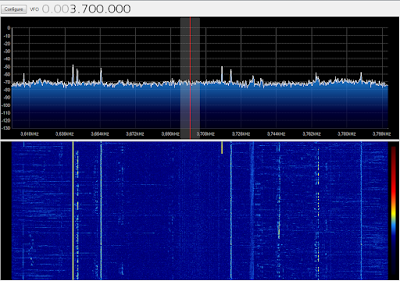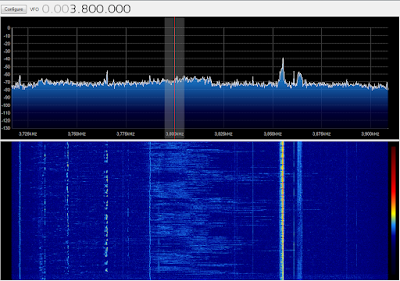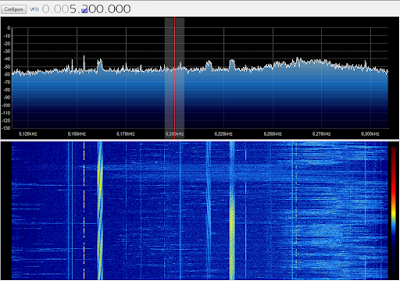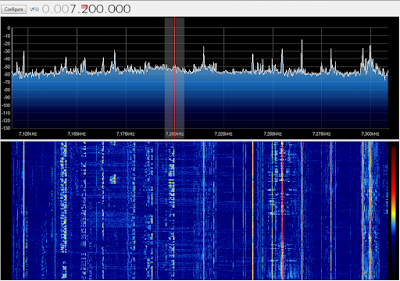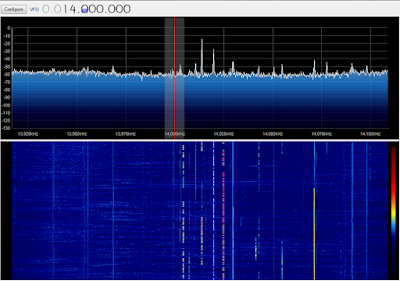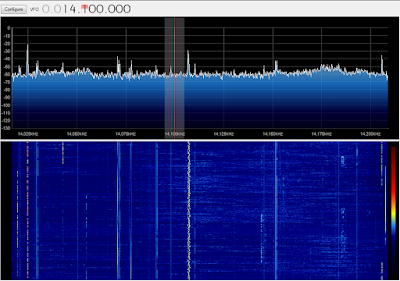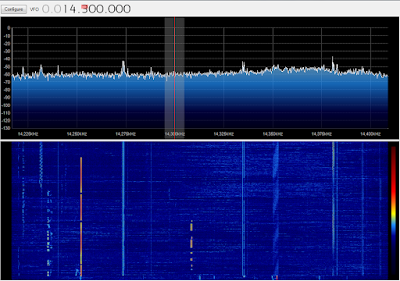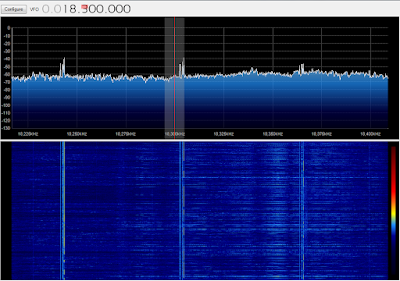Author Archive
 Some Radio Antics
Some Radio Antics
Shack activity has been curtailed with the antenna 'mast' spending a lot of time luffed over due of the winter storms and high winds that have battered the UK over recent weeks.
Thankfully things calmed down and was able to put the antenna back up but I seemed a little deaf on VHF/UHF dropping several S-points on local repeaters and then started to see high VSWR readings. The incessant rain had somehow got into the connector under the collinear despite being generously wrapped in self amalgamating tape. I replaced the connector and removed a couple of feet of coax in case any had seeped into the cable.
Like much of the UK amateur community I have been trying to listen in to British Astronaut Major Tim Peake during a number of ARISS UK school contacts during the Principia mission on the International Space Station. It is pleasing to see the enthusiasm, interest and publicity it has generated for the hobby.
There is another contact tomorrow (Friday 26th February 2016 at 1440UTC) with the City of Norwich School. While reception of the first two contacts proved a little disappointing for me, the one last week was much better and I made a video during the pass.
The Astronauts are certainly busy on the space station and there was an ARISS contact this morning with an Italian school. It was a low pass here only reaching 7 degrees above the horizon but was pleased to capture Tim Kopra conversing. I was using just the X-50 collinear on the FT857-D
The repaired ATU and a new balun on the OCFD has made a big difference to HF. It is much less noisy and I am now able to match the antenna to 80m something I could never do before. While it will be very inefficient on such a short antenna I did run a little over 2W last night on WSPR as a test, and was pleasantly surprised.
I have also been doing some JT65 and for the first time some JT9 inspired by a demonstration at SKARS and I was pleased to make a JT9 QSO with JA5BDZ on 15m using 10W.
A big help to HF has been tracking down the source of my recent QRM, which wasn't as many suggested my evil PLT devices but in fact the now redundant wireless router. While the WiFi was switched off it was still being used as a network switch and for some reason had suddenly become RF noisy, it wasn't the switching PSU but the actual unit and would happen a few hours after being switched on. Funny thing it is not the first time I've had an access point suddenly emit QRM.
A couple of weeks ago I went out with Stewart (M0SDM) to assist him flying his kite antenna and we operated under the club callsign MX0SKR, for a couple of hours, it was great fun.
Last weekend I also helped my brother David (M6GTD) install a couple of antennas at the family home. He can finally use the radio he brought at the Hamfest back in September, a Diamond X-50 dual band collinear and a home brewed 33ft long OCFD should get him on the air!
David helped me at the Hamfest with the balloon launch
My apologies if this blog post sounds like a bit like an excited child recanting his holiday "I did this, and then I did this and I also did that" I hope to post something a little more coherent and structured soon!
Thankfully things calmed down and was able to put the antenna back up but I seemed a little deaf on VHF/UHF dropping several S-points on local repeaters and then started to see high VSWR readings. The incessant rain had somehow got into the connector under the collinear despite being generously wrapped in self amalgamating tape. I replaced the connector and removed a couple of feet of coax in case any had seeped into the cable.
Like much of the UK amateur community I have been trying to listen in to British Astronaut Major Tim Peake during a number of ARISS UK school contacts during the Principia mission on the International Space Station. It is pleasing to see the enthusiasm, interest and publicity it has generated for the hobby.
There is another contact tomorrow (Friday 26th February 2016 at 1440UTC) with the City of Norwich School. While reception of the first two contacts proved a little disappointing for me, the one last week was much better and I made a video during the pass.
The Astronauts are certainly busy on the space station and there was an ARISS contact this morning with an Italian school. It was a low pass here only reaching 7 degrees above the horizon but was pleased to capture Tim Kopra conversing. I was using just the X-50 collinear on the FT857-D
The repaired ATU and a new balun on the OCFD has made a big difference to HF. It is much less noisy and I am now able to match the antenna to 80m something I could never do before. While it will be very inefficient on such a short antenna I did run a little over 2W last night on WSPR as a test, and was pleasantly surprised.
I have also been doing some JT65 and for the first time some JT9 inspired by a demonstration at SKARS and I was pleased to make a JT9 QSO with JA5BDZ on 15m using 10W.
A big help to HF has been tracking down the source of my recent QRM, which wasn't as many suggested my evil PLT devices but in fact the now redundant wireless router. While the WiFi was switched off it was still being used as a network switch and for some reason had suddenly become RF noisy, it wasn't the switching PSU but the actual unit and would happen a few hours after being switched on. Funny thing it is not the first time I've had an access point suddenly emit QRM.
A couple of weeks ago I went out with Stewart (M0SDM) to assist him flying his kite antenna and we operated under the club callsign MX0SKR, for a couple of hours, it was great fun.
Last weekend I also helped my brother David (M6GTD) install a couple of antennas at the family home. He can finally use the radio he brought at the Hamfest back in September, a Diamond X-50 dual band collinear and a home brewed 33ft long OCFD should get him on the air!
David helped me at the Hamfest with the balloon launch
My apologies if this blog post sounds like a bit like an excited child recanting his holiday "I did this, and then I did this and I also did that" I hope to post something a little more coherent and structured soon!
 Poetic justice?
Poetic justice?
Following my last post it is perhaps ironic that for the last few evenings I have been plagued by an increase in QRM.
Trying some JT65 on 40m I was being plagued by S8-S9 of local noise, it is noise I have had regularly (even before the purchase of my PLT devices) so I reconnected up the WiMo QRM Eliminator, which has been collecting dust, to see if I could improve matters.
Using just a short piece of wire as the auxillary 'noise' antenna managed to null out most of it to greatly improve reception. No commentary on the video below but hopefully you can see it working.
Interestingly the noise seems to abate around 11pm when people are off to bed.
Trying some JT65 on 40m I was being plagued by S8-S9 of local noise, it is noise I have had regularly (even before the purchase of my PLT devices) so I reconnected up the WiMo QRM Eliminator, which has been collecting dust, to see if I could improve matters.
Using just a short piece of wire as the auxillary 'noise' antenna managed to null out most of it to greatly improve reception. No commentary on the video below but hopefully you can see it working.
Interestingly the noise seems to abate around 11pm when people are off to bed.
 Poetic justice?
Poetic justice?
Following my last post it is perhaps ironic that for the last few evenings I have been plagued by an increase in QRM.
Trying some JT65 on 40m I was being plagued by S8-S9 of local noise, it is noise I have had regularly (even before the purchase of my PLT devices) so I reconnected up the WiMo QRM Eliminator, which has been collecting dust, to see if I could improve matters.
Using just a short piece of wire as the auxillary 'noise' antenna managed to null out most of it to greatly improve reception. No commentary on the video below but hopefully you can see it working.
Interestingly the noise seems to abate around 11pm when people are off to bed.
Trying some JT65 on 40m I was being plagued by S8-S9 of local noise, it is noise I have had regularly (even before the purchase of my PLT devices) so I reconnected up the WiMo QRM Eliminator, which has been collecting dust, to see if I could improve matters.
Using just a short piece of wire as the auxillary 'noise' antenna managed to null out most of it to greatly improve reception. No commentary on the video below but hopefully you can see it working.
Interestingly the noise seems to abate around 11pm when people are off to bed.
 PLT Devices – Have I welcomed the Devil in to the shack?
PLT Devices – Have I welcomed the Devil in to the shack?
I joked recently about turning to the Dark Side, well my conversion really was complete after the Boxing Day sales.
I need to set up the ability to remotely operate the station via the internet as well as experiment with internet linking systems but the wi-fi link to the shack isn't fast or reliable enough. Now if I do a scan looking for wi-fi networks I can see well over a dozen, some of them quite strong and more are popping up all the time and I suspect this congestion is part of my problem.
The Samsung Smart TV in the house was also wi-fi linked but we were having increasing issues with the BBC iPlayer and Netflix with buffering or poor quality images because of poor signal and data rates.
Ideally I would be like to fit proper ethernet cables but it is totally impractical without major upheaval or unsightly trunking a definite no-no. In the end the only workable and affordable solution seemed to be to get some of those evil Powerline Transmission (PLT) devices.
I have suffered strong sporadic QRM myself which I have assumed were neighbours PLT networking devices as I'd read the horror stories, seen the videos and anecdotal reports of mains borne noise caused by them. So I hadn't even considered it until I saw a post and video by Dan Trudgian (M0TGN) about his experiences of using some Netgear devices and the apparant lack of interference to his radio activities. Some members of South Kesteven ARS had also started using them, so I took the plunge and ordered some Netgear ones reduced on Amazon in the Boxing Day sales.
Setting them up was easy, but the acid test was how much noise did they generate? I set up one device in the shack at the far end of the mains cable run to maximise radiation. Streaming internet radio and a HD movie on Netflix I then used the FUNCube Dongle PRO+ SDR connected to the OCFD to see what noise they were generating.
Here are my observations going through the various HF bands. Where noise is present I first stopped the streaming and then powered off the devices to eliminate them as the cause, where they were the cause it seemed eliminating the network traffic was sufficient to greatly reduce the effect.
While the antenna isn't optimised for 80m, signals can be seen as well as noise. Before you get excited this noise has been present for quite a while and isn't being caused by the new Netgear devices. This noise is what I suspected was generated by PLT devices used by my neighbours.
Shocking noise but again this isn't caused by my new devices, the noise has the same characteristics as that seen on 80m.
The band was busy, there is some noise again but not from the new devices, this was looking encouraging. I have also showed the adjacent broadcast band.
Again, largely noise free
Still largely noise free, the QRM that is present still wasn't due to the new devices
This was the first indication of QRM from the new devices, however it appears effectively filtered to leave the amateur allocation clear. The faint noise in the middle picture is not from the new devices.
Again this band was clear of noise
Showing the two ends of the band again the clear signal/noise from the devices again seems effectively filtered
While the amateur bands appear to be filtered, the transmission can of course can clearly be seen on some non-amateur bands and apart from 16 meters seems to avoid the broadcast bands.
This fairly rudimentary testing has largely given me confidence that they won't be any issues. The band conditions weren't brilliant when I did test, but even with the absence of signals on the band any noise would be evident as seen. Yes they clearly do generate QRM but thankfully not it seems in the amateur bands. I haven't heard any extra noise on any of the radios over the last few days so all is looking promising. I will keep you posted if there is any change.
I need to set up the ability to remotely operate the station via the internet as well as experiment with internet linking systems but the wi-fi link to the shack isn't fast or reliable enough. Now if I do a scan looking for wi-fi networks I can see well over a dozen, some of them quite strong and more are popping up all the time and I suspect this congestion is part of my problem.
The Samsung Smart TV in the house was also wi-fi linked but we were having increasing issues with the BBC iPlayer and Netflix with buffering or poor quality images because of poor signal and data rates.
Ideally I would be like to fit proper ethernet cables but it is totally impractical without major upheaval or unsightly trunking a definite no-no. In the end the only workable and affordable solution seemed to be to get some of those evil Powerline Transmission (PLT) devices.
I have suffered strong sporadic QRM myself which I have assumed were neighbours PLT networking devices as I'd read the horror stories, seen the videos and anecdotal reports of mains borne noise caused by them. So I hadn't even considered it until I saw a post and video by Dan Trudgian (M0TGN) about his experiences of using some Netgear devices and the apparant lack of interference to his radio activities. Some members of South Kesteven ARS had also started using them, so I took the plunge and ordered some Netgear ones reduced on Amazon in the Boxing Day sales.
Setting them up was easy, but the acid test was how much noise did they generate? I set up one device in the shack at the far end of the mains cable run to maximise radiation. Streaming internet radio and a HD movie on Netflix I then used the FUNCube Dongle PRO+ SDR connected to the OCFD to see what noise they were generating.
Here are my observations going through the various HF bands. Where noise is present I first stopped the streaming and then powered off the devices to eliminate them as the cause, where they were the cause it seemed eliminating the network traffic was sufficient to greatly reduce the effect.
80 Meters
While the antenna isn't optimised for 80m, signals can be seen as well as noise. Before you get excited this noise has been present for quite a while and isn't being caused by the new Netgear devices. This noise is what I suspected was generated by PLT devices used by my neighbours.
60 Meters
Shocking noise but again this isn't caused by my new devices, the noise has the same characteristics as that seen on 80m.
40 Meters
The band was busy, there is some noise again but not from the new devices, this was looking encouraging. I have also showed the adjacent broadcast band.
30 Meters
Again, largely noise free
20 Meters
Still largely noise free, the QRM that is present still wasn't due to the new devices
17 Meters
This was the first indication of QRM from the new devices, however it appears effectively filtered to leave the amateur allocation clear. The faint noise in the middle picture is not from the new devices.
15 Meters
Again this band was clear of noise
12 Meters
Showing the two ends of the band again the clear signal/noise from the devices again seems effectively filtered
10 Meter
I didn't observe any additional noise on this band, but unfortunately deleted the screen grabs ;-)So where was the QRM?
While the amateur bands appear to be filtered, the transmission can of course can clearly be seen on some non-amateur bands and apart from 16 meters seems to avoid the broadcast bands.
Conclusion
These Netgear XAVB5221 devices seem effective, indeed doing a speedtest in the shack was more than acceptable (the dire upload speed is a 'feature' of my cable ISP)This fairly rudimentary testing has largely given me confidence that they won't be any issues. The band conditions weren't brilliant when I did test, but even with the absence of signals on the band any noise would be evident as seen. Yes they clearly do generate QRM but thankfully not it seems in the amateur bands. I haven't heard any extra noise on any of the radios over the last few days so all is looking promising. I will keep you posted if there is any change.
 PLT Devices – Have I welcomed the Devil in to the shack?
PLT Devices – Have I welcomed the Devil in to the shack?
I joked recently about turning to the Dark Side, well my conversion really was complete after the Boxing Day sales.
I need to set up the ability to remotely operate the station via the internet as well as experiment with internet linking systems but the wi-fi link to the shack isn't fast or reliable enough. Now if I do a scan looking for wi-fi networks I can see well over a dozen, some of them quite strong and more are popping up all the time and I suspect this congestion is part of my problem.
The Samsung Smart TV in the house was also wi-fi linked but we were having increasing issues with the BBC iPlayer and Netflix with buffering or poor quality images because of poor signal and data rates.
Ideally I would be like to fit proper ethernet cables but it is totally impractical without major upheaval or unsightly trunking a definite no-no. In the end the only workable and affordable solution seemed to be to get some of those evil Powerline Transmission (PLT) devices.
I have suffered strong sporadic QRM myself which I have assumed were neighbours PLT networking devices as I'd read the horror stories, seen the videos and anecdotal reports of mains borne noise caused by them. So I hadn't even considered it until I saw a post and video by Dan Trudgian (M0TGN) about his experiences of using some Netgear devices and the apparant lack of interference to his radio activities. Some members of South Kesteven ARS had also started using them, so I took the plunge and ordered some Netgear ones reduced on Amazon in the Boxing Day sales.
Setting them up was easy, but the acid test was how much noise did they generate? I set up one device in the shack at the far end of the mains cable run to maximise radiation. Streaming internet radio and a HD movie on Netflix I then used the FUNCube Dongle PRO+ SDR connected to the OCFD to see what noise they were generating.
Here are my observations going through the various HF bands. Where noise is present I first stopped the streaming and then powered off the devices to eliminate them as the cause, where they were the cause it seemed eliminating the network traffic was sufficient to greatly reduce the effect.
While the antenna isn't optimised for 80m, signals can be seen as well as noise. Before you get excited this noise has been present for quite a while and isn't being caused by the new Netgear devices. This noise is what I suspected was generated by PLT devices used by my neighbours.
Shocking noise but again this isn't caused by my new devices, the noise has the same characteristics as that seen on 80m.
The band was busy, there is some noise again but not from the new devices, this was looking encouraging. I have also showed the adjacent broadcast band.
Again, largely noise free
Still largely noise free, the QRM that is present still wasn't due to the new devices
This was the first indication of QRM from the new devices, however it appears effectively filtered to leave the amateur allocation clear. The faint noise in the middle picture is not from the new devices.
Again this band was clear of noise
Showing the two ends of the band again the clear signal/noise from the devices again seems effectively filtered
While the amateur bands appear to be filtered, the transmission can of course can clearly be seen on some non-amateur bands and apart from 16 meters seems to avoid the broadcast bands.
This fairly rudimentary testing has largely given me confidence that they won't be any issues. The band conditions weren't brilliant when I did test, but even with the absence of signals on the band any noise would be evident as seen. Yes they clearly do generate QRM but thankfully not it seems in the amateur bands. I haven't heard any extra noise on any of the radios over the last few days so all is looking promising. I will keep you posted if there is any change.
I need to set up the ability to remotely operate the station via the internet as well as experiment with internet linking systems but the wi-fi link to the shack isn't fast or reliable enough. Now if I do a scan looking for wi-fi networks I can see well over a dozen, some of them quite strong and more are popping up all the time and I suspect this congestion is part of my problem.
The Samsung Smart TV in the house was also wi-fi linked but we were having increasing issues with the BBC iPlayer and Netflix with buffering or poor quality images because of poor signal and data rates.
Ideally I would be like to fit proper ethernet cables but it is totally impractical without major upheaval or unsightly trunking a definite no-no. In the end the only workable and affordable solution seemed to be to get some of those evil Powerline Transmission (PLT) devices.
I have suffered strong sporadic QRM myself which I have assumed were neighbours PLT networking devices as I'd read the horror stories, seen the videos and anecdotal reports of mains borne noise caused by them. So I hadn't even considered it until I saw a post and video by Dan Trudgian (M0TGN) about his experiences of using some Netgear devices and the apparant lack of interference to his radio activities. Some members of South Kesteven ARS had also started using them, so I took the plunge and ordered some Netgear ones reduced on Amazon in the Boxing Day sales.
Setting them up was easy, but the acid test was how much noise did they generate? I set up one device in the shack at the far end of the mains cable run to maximise radiation. Streaming internet radio and a HD movie on Netflix I then used the FUNCube Dongle PRO+ SDR connected to the OCFD to see what noise they were generating.
Here are my observations going through the various HF bands. Where noise is present I first stopped the streaming and then powered off the devices to eliminate them as the cause, where they were the cause it seemed eliminating the network traffic was sufficient to greatly reduce the effect.
80 Meters
While the antenna isn't optimised for 80m, signals can be seen as well as noise. Before you get excited this noise has been present for quite a while and isn't being caused by the new Netgear devices. This noise is what I suspected was generated by PLT devices used by my neighbours.
60 Meters
Shocking noise but again this isn't caused by my new devices, the noise has the same characteristics as that seen on 80m.
40 Meters
The band was busy, there is some noise again but not from the new devices, this was looking encouraging. I have also showed the adjacent broadcast band.
30 Meters
Again, largely noise free
20 Meters
Still largely noise free, the QRM that is present still wasn't due to the new devices
17 Meters
This was the first indication of QRM from the new devices, however it appears effectively filtered to leave the amateur allocation clear. The faint noise in the middle picture is not from the new devices.
15 Meters
Again this band was clear of noise
12 Meters
Showing the two ends of the band again the clear signal/noise from the devices again seems effectively filtered
10 Meter
I didn't observe any additional noise on this band, but unfortunately deleted the screen grabs ;-)So where was the QRM?
While the amateur bands appear to be filtered, the transmission can of course can clearly be seen on some non-amateur bands and apart from 16 meters seems to avoid the broadcast bands.
Conclusion
These Netgear XAVB5221 devices seem effective, indeed doing a speedtest in the shack was more than acceptable (the dire upload speed is a 'feature' of my cable ISP)This fairly rudimentary testing has largely given me confidence that they won't be any issues. The band conditions weren't brilliant when I did test, but even with the absence of signals on the band any noise would be evident as seen. Yes they clearly do generate QRM but thankfully not it seems in the amateur bands. I haven't heard any extra noise on any of the radios over the last few days so all is looking promising. I will keep you posted if there is any change.
 Repaired my ATU
Repaired my ATU
Merry Christmas!
Not wishing to contend with an evening of dire XYL style Christmas TV (Strictly Come Dancing, Call the Midwife and Downton Abbey) I escaped into the shack and decided to repair my Vectronics VC300DLP Antenna Tuner. I got this ATU second hand last year and while it has been serviceable it had become temperamental of late. The units rotary inductor switch had become stiff and suddenly I was unable to match the OCFD on some bands so it had clearly broken.
I had a 12-position switch (rated at 5A) and knob, originally sourced for an abandoned project and hoped it would be suitable. The existing switch knob on the ATU wasn't an original, I'd assumed it had replaced one lost or broken. When I removed the cover it was clear that the whole switch had already been changed at sometime.
I also noticed a prominent burn mark inside the inductor coil, caused by a clear break in the insulation of the wire which was resting on the grounded bottom plate.
I know the previous owner of the ATU has a 300W RM BLA-350 linear amplifier, whereas I only normally operate around 30W maximum at my QTH, so not sure how much of this arcing I had caused but it needed sorting! A little over half an hour with the soldering iron and I had replaced the switch and slipped some heat shrink over the broken insulation and re-soldered the wire, lifting it off the ground plate.
The ATU seems to work well, now fitted with a new knob (just missing a cap at the moment) the switch turns nicely. I also cleaned up the SO-239 connectors on the back as they were tarnished and oxidised. I used a small bit of contact cleaner on some cotton buds to clean up the threads and the centre pins, removing a surprising amount of crud. The patch and antenna leads now screws on much better.
With the Mother--in-law staying with us over the festive period I suspect I may be in the shack quite a bit, I have plenty of jobs and half finished projects to keep me busy!
Not wishing to contend with an evening of dire XYL style Christmas TV (Strictly Come Dancing, Call the Midwife and Downton Abbey) I escaped into the shack and decided to repair my Vectronics VC300DLP Antenna Tuner. I got this ATU second hand last year and while it has been serviceable it had become temperamental of late. The units rotary inductor switch had become stiff and suddenly I was unable to match the OCFD on some bands so it had clearly broken.
I had a 12-position switch (rated at 5A) and knob, originally sourced for an abandoned project and hoped it would be suitable. The existing switch knob on the ATU wasn't an original, I'd assumed it had replaced one lost or broken. When I removed the cover it was clear that the whole switch had already been changed at sometime.
I also noticed a prominent burn mark inside the inductor coil, caused by a clear break in the insulation of the wire which was resting on the grounded bottom plate.
I know the previous owner of the ATU has a 300W RM BLA-350 linear amplifier, whereas I only normally operate around 30W maximum at my QTH, so not sure how much of this arcing I had caused but it needed sorting! A little over half an hour with the soldering iron and I had replaced the switch and slipped some heat shrink over the broken insulation and re-soldered the wire, lifting it off the ground plate.
The ATU seems to work well, now fitted with a new knob (just missing a cap at the moment) the switch turns nicely. I also cleaned up the SO-239 connectors on the back as they were tarnished and oxidised. I used a small bit of contact cleaner on some cotton buds to clean up the threads and the centre pins, removing a surprising amount of crud. The patch and antenna leads now screws on much better.
With the Mother--in-law staying with us over the festive period I suspect I may be in the shack quite a bit, I have plenty of jobs and half finished projects to keep me busy!
 Repaired my ATU
Repaired my ATU
Merry Christmas!
Not wishing to contend with an evening of dire XYL style Christmas TV (Strictly Come Dancing, Call the Midwife and Downton Abbey) I escaped into the shack and decided to repair my Vectronics VC300DLP Antenna Tuner. I got this ATU second hand last year and while it has been serviceable it had become temperamental of late. The units rotary inductor switch had become stiff and suddenly I was unable to match the OCFD on some bands so it had clearly broken.
I had a 12-position switch (rated at 5A) and knob, originally sourced for an abandoned project and hoped it would be suitable. The existing switch knob on the ATU wasn't an original, I'd assumed it had replaced one lost or broken. When I removed the cover it was clear that the whole switch had already been changed at sometime.
I also noticed a prominent burn mark inside the inductor coil, caused by a clear break in the insulation of the wire which was resting on the grounded bottom plate.
I know the previous owner of the ATU has a 300W RM BLA-350 linear amplifier, whereas I only normally operate around 30W maximum at my QTH, so not sure how much of this arcing I had caused but it needed sorting! A little over half an hour with the soldering iron and I had replaced the switch and slipped some heat shrink over the broken insulation and re-soldered the wire, lifting it off the ground plate.
The ATU seems to work well, now fitted with a new knob (just missing a cap at the moment) the switch turns nicely. I also cleaned up the SO-239 connectors on the back as they were tarnished and oxidised. I used a small bit of contact cleaner on some cotton buds to clean up the threads and the centre pins, removing a surprising amount of crud. The patch and antenna leads now screws on much better.
With the Mother--in-law staying with us over the festive period I suspect I may be in the shack quite a bit, I have plenty of jobs and half finished projects to keep me busy!
Not wishing to contend with an evening of dire XYL style Christmas TV (Strictly Come Dancing, Call the Midwife and Downton Abbey) I escaped into the shack and decided to repair my Vectronics VC300DLP Antenna Tuner. I got this ATU second hand last year and while it has been serviceable it had become temperamental of late. The units rotary inductor switch had become stiff and suddenly I was unable to match the OCFD on some bands so it had clearly broken.
I had a 12-position switch (rated at 5A) and knob, originally sourced for an abandoned project and hoped it would be suitable. The existing switch knob on the ATU wasn't an original, I'd assumed it had replaced one lost or broken. When I removed the cover it was clear that the whole switch had already been changed at sometime.
I also noticed a prominent burn mark inside the inductor coil, caused by a clear break in the insulation of the wire which was resting on the grounded bottom plate.
I know the previous owner of the ATU has a 300W RM BLA-350 linear amplifier, whereas I only normally operate around 30W maximum at my QTH, so not sure how much of this arcing I had caused but it needed sorting! A little over half an hour with the soldering iron and I had replaced the switch and slipped some heat shrink over the broken insulation and re-soldered the wire, lifting it off the ground plate.
The ATU seems to work well, now fitted with a new knob (just missing a cap at the moment) the switch turns nicely. I also cleaned up the SO-239 connectors on the back as they were tarnished and oxidised. I used a small bit of contact cleaner on some cotton buds to clean up the threads and the centre pins, removing a surprising amount of crud. The patch and antenna leads now screws on much better.
With the Mother--in-law staying with us over the festive period I suspect I may be in the shack quite a bit, I have plenty of jobs and half finished projects to keep me busy!





